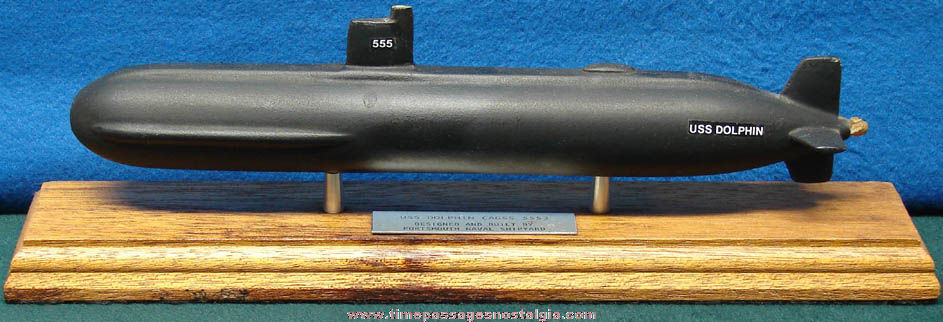
   | | | Any group of items being offered as a lot must be sold as a lot. | | Quantity Discount Prices
(when available) | Don't forget to
bookmark this site. | You don't have to be an eight year old to enjoy having
a childhood treasure. | | We have an extensive inventory that is not yet on our web site. If there is something you are looking for and did not find, please send us your wish list. | | Unique & Fun Nostalgic Items | Great memories
make great gifts! | It's never too late to
have a happy childhood! | Whether you've collected Memorabilia for years or just want to feel like a kid again, please take a few moments to browse through what we
have available for sale. |
| | | | The pictures show views of this 1960s U.S. Navy Submarine U.S.S. Dolphin AGSS-555 Shipyard Desk Model. Shown is a view of the entire model on its wooden base and a closer view of the engraved plate on the base. There are ''USS DOLPHIN'' and ''555'' decals on both sides. There is black felt on the bottom of the wooden base. The engraved plate is marked as follows: USS DOLPHIN (AGSS 555)
DESIGNED AND BUILT BY
PORTSMOUTH NAVAL SHIPYARD To judge the size the entire model with the base measures about 13-5/8'' x 4-1/8'' x 2-3/4''. It appears to be in excellent condition as pictured. There may have been an antenna or periscope on the tower at one time. The propeller is missing its blades, but it can be replaced. Below here, for reference, is some historic information on the U.S.S. Dolphin: U.S.S. Dolphin (AGSS-555)
From Wikipedia, the free encyclopedia Career Name: U.S.S. Dolphin
Ordered: 10 August 1960
Laid down: 9 November 1962
Launched: 8 June 1968
Commissioned: 17 August 1968
Decommissioned: 15 January 2007
Out of service: 22 September 2006
Struck: 15 January 2007
Fate: Museum ship General characteristics
Displacement: 805 long tons (818 t) light, 861 long tons (875 t) full load
56 long tons (57 t) dead
Length: 46.3 m (151 ft. 11 in.)
Beam: 6 m (19 ft. 8 in.)
Draft: 4.8 m (15 ft. 9 in.)
Propulsion: 2 General Motors V71 12 cylinder diesel engines, 425 hp (317 kW), 2 electric main motors, 330 cell silver oxide battery
Speed: 10 knots (12 mph; 19 km/h) surfaced, 7.5 knots (8.6 mph; 13.9 km/h) submerged, (10 knot sprint, 3-4 knots sustained. When based at Mare Island Naval Shipyard Dolphin had to take the tide into account as its top surfaced speed was less than the incoming tide. Though its top speed is oft quoted at 10 knots (12 mph; 19 km/h) this is only under ideal conditions and was never achievable under operating conditions)
Endurance: 15 days
Test depth: 1,500 ft. (460 m) operating, 3,000 ft. (910 m) test (unclassified)
Capacity: 12 tons on external mounting pads, six port, six starboard, forward and aft of sail
Complement: 3 officers, 20 men, 4 scientists (46 crew, all are not deployed.)
Armament: .45 pistol, M14 rifle and shotgun for port defense, Externally mounted 21 inch (53 cm) Deep Experimental Torpedo (DExTor) torpedo tube was used for test firing
Notes: fitted with a 20 ton keel section to be jettisoned by explosive bolts for surfacing under emergency conditions.The U.S.S. Dolphin (AGSS-555) was the United States Navy's only operational diesel electric, deep diving, research and development submarine. Her keel was laid down on 9 November 1962 at the Portsmouth Navy Yard, Kittery, Maine. She was launched on 8 June 1968 sponsored by Mrs. Daniel K. Inouye (the wife of the senator for Hawaii), and commissioned on 17 August 1968 with Lieutenant Commander J. R. McDonnell in command. Despite her recent repair and upgrade, Dolphin was decommissioned on 15 January 2007 and was struck from the Naval Vessel Register on the same date. She is now a museum ship in San Diego Bay under the management of the San Diego Maritime Museum. Design
The single most significant technical achievement in the development of Dolphin is the pressure hull itself. It is a constant diameter cylinder, closed at its ends with hemispherical heads, and utilizes deep frames instead of bulkheads. The entire design of the pressure hull has been kept as simple as possible to facilitate its use in structural experiments and trials. Hull openings have been minimized for structural strength and minimum hull weight, in addition to eliminating possible sources for flooding casualties. The submarine has no snorkel mast; her one hatch must be open while her diesels are running. Use
Employed by both civilian and Navy activities, Dolphin is equipped with an extensive instrumentation suite that supports missions such as acoustic deep water and littoral research, near bottom and ocean surveys, weapons launches, sensor trials, and engineering evaluations.
Because she was designed as a test platform, Dolphin can be modified both internally and externally to allow installation of up to 12 tons of special research and test equipment. The submarine has internal and external mounting points, multiple electronic hull connectors, and up to ten equipment racks for project use.Service Record
In August 1969, Dolphin launched a torpedo from the deepest depth that one has ever been fired. Other examples of Dolphin's work include The first successful submarine to aircraft optical communications
The development of a Laser Imaging system of photographic clarity
The development of an Extreme Low Frequency (ELF) antenna for Ohio class submarines
The evaluation of various non-acoustic ASW techniques
The evaluation of various low probability of interception active sonars
The first submarine launch of a mobile submarine simulator (MOSS) system
Thefirst successful submarine test of BQS-15 sonar system
The development of highly accurate (10 cm) towed body position monitoring system
The development of a new Obstacle Avoidance Sonar system
The development of a highly accurate target management system
The evaluation of a possible ''fifth force of nature''
The first successful submarine to aircraft two way laser communication
The deepest submarine dive more than 3,000 feet. The Dolphin was overhauled in 1993. In the late 1990s, Dolphin tested a new sonar system. As a result of Dolphin's efforts, this new system will now be retrofitted into the fleet. Abandonment at Sea Incident
On 21 May 2002, at about 1130 PDT, while operating approximately 100 miles (160 km) off the coast of San Diego, California, the USS Dolphin was cruising on the surface, recharging its batteries, when a torpedo shield door gasket failed, and the boat began to flood. Due to high winds and 10 to 11 foot (3.0 to 3.4 m) swells in the ocean, approximately 70 to 85 tons of seawater entered the ship, an amount perilously close to the boat's reserve buoyancy. The flooding shorted electrical panels and started fires. Chief Machinist's Mate (SS) John D. Wise Jr., realizing what needed to be done, dove into the 57 °F (14 °C) water of the flooded pump room. Not knowing if the room's equipment had been secured, and with less than a foot of breathable space in the compartment, he ensured the seawater valves were lined up, allowing the de-watering to commence. Once the valves were aligned, he remained in the pump room for more than 90 minutes in order to keep a submersible pump from becoming clogged. His courageous efforts prevented the loss of the ship and crew. Wise received the Navy and Marine Corps Medal for his efforts. After 90 minutes, Commander Stephen Kelety, Dolphin's commanding officer, ordered the crew of 41 and two civilian Navy employees to abandon ship. The Oceanographic Research ship McGaw was operating in the vicinity and immediately responded. The fire and flooding was beyond the ability of the crew to control so they were evacuated by small boat to McGaw after the submarine hatches had been secured. All crewmembers were safely recovered with only a few minor injuries. Two crewmembers were recovered from the water by United States Coast Guard helicopter during the transfer. McGaw transported the crew to San Diego. The quick response of the crew placed the submarine in a stable condition. The U.S.S. Thach (FFG-43) came alongside Dolphin and rescued several crewman from the water but the seas were too rough for full recovery or towing operations. Submarine Support Vessel Kellie Chouest got underway from San Diego early on 22 May to assist in the recovery assessment. Dolphin was towed back to San Diego the following day. The last time an American submarine caught fire and was abandoned was in 1988, when the diesel sub U.S.S. Bonefish (SS-582) lost three sailors in a battery compartment fire. Retirement
The Dolphin underwent three and a half years of repairs and upgrades at a cost of $50 million, then completed sea trials during the summer of 2005 and returned to her duties for one year. In mid 2006, the Navy decided to retire Dolphin, citing the $18 million her operations cost annually. She was deactivated on 22 September 2006, and decommissioned and struck from the Naval Vessel Register on 15 January 2007. ex-Dolphin was officially transferred to the San Diego Maritime Museum in September, 2008, to become the eighth vessel in their floating collection. She was opened to the public for the first time on July 4, 2009. |
|
Click on image to zoom.
  |